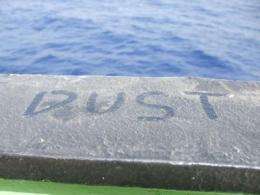Bacterioplankton responses to desert dust in the (sub)tropical northeast Atlantic

Inputs of dust from the Sahara desert could change the composition of microbial communities in the (sub)tropical eastern North Atlantic say Southampton researchers writing this month in the journal FEMS Microbiology Letters.
When high winds blow over the Sahara, dust particles consisting of soil particles are lifted high into the atmosphere, blown over the sea, and then deposited on the ocean surface.
"Desert dust particles contain nutrients such as iron that can boost the production of tiny planktonic plants called phytoplankton as well as bacteria in some oceanic regions," explained researcher Polly Hill, a PhD student at the University of Southampton's School of Ocean and Earth Science (SOES) based at the National Oceanography Centre (NOC) in Southampton.
The new research was conducted aboard the Royal Research Ship Discovery in the eastern (sub)tropical North Atlantic Ocean during January-February 2008.
"During the voyage a huge cloud of Saharan dust came over, turning the sky brown and covering the ship in a layer of red-brown dust. The dust cloud was clearly visible in satellite images," recalled Hill.
Hill and her colleagues Mike Zubkov and Duncan Purdie experimentally assessed the affect of oceanic dust deposition on the metabolic activity of marine bacteria (bacterioplankton) contained in seawater samples collected at a depth of 20 metres. They focused on two types of bacteria, Prochlorococcus and SAR11.
"Prochlorococcus bacteria are the dominant phytoplankton group in the subtropical and tropical ocean and are responsible for a large proportion of carbon dioxide fixation in those regions. Conversely, SAR11 bacteria respire organic carbon and release carbon dioxide," said Hill.
The researchers' experiments aboard ship showed that dust inputs generally advantaged SAR11 over Prochlorococcus, for which these inputs may even be detrimental.
"This means that large inputs of Saharan dust has the potential to change the composition of the bacterioplankton community in the (sub)tropical North Atlantic, as has been shown previously for some other oceanic regions," concluded Hill.
More information: Hill, P. G., Zubkov, M. V. & Purdie, D. A. Differential responses of Prochlorococcus and SAR11-dominated bacterioplankton groups to atmospheric dust inputs in the tropical Northeast Atlantic Ocean. FEMS Microbiology Letters 306, 82-89 (2010).
Provided by National Oceanography Centre, Southampton















